
VR-Group Plc, commonly known as VR, is a government-owned railway company in Finland. VR's most important function is the operation of Finland's passenger rail services with 250 long-distance and 800 commuter rail services every day. With 7,500 employees and net sales of €1,251 million in 2017, VR is one of the most significant operators in the Finnish public transport market area.

The Finnish railway network consists of a total track length of 9,216 km (5,727 mi). The railways are built with a broad 1,524 mm track gauge, of which 3,249 km (2,019 mi) is electrified. Passenger trains are operated by the state-owned enterprise VR that runs services on 7,225 km (4,489 mi) of track. These services cover all major cities and many rural areas, though the coverage is less than the coverage provided by the bus services. Most passenger train services originate or terminate at Helsinki Central railway station, and a large proportion of the passenger rail network radiates out of Helsinki. VR also operates freight services. Maintenance and construction of the railway network itself is the responsibility of the Finnish Rail Administration, which is a part of the Finnish Transport Agency. The network consists of six areal centres, that manage the use and maintenance of the routes in co-operation. Cargo yards and large stations may have their own signalling systems.

Louhela railway station is a VR commuter rail station located in Vantaa, Finland. It is approximately thirteen kilometres north of Helsinki Central railway station.

The Sr2 is a class of electric locomotives of the VR Group. They were built by SLM/ABB and later by Adtranz and finally Bombardier Transportation and assembled by Transtech Oy. They are closely based on the class Re 460 locomotives of Swiss Federal Railways.

The Sm3 Pendolino is a class of high-speed body-tilting trains operated by VR Group. It is a member of the Pendolino train family; its design is based on the ETR 460. The first two trainsets were assembled in Finland by Rautaruukki-Transtech in the mid-1990s. The rest of the series of eighteen EMUs were built by Fiat Ferroviaria between 2000 and 2006. The trains serve most of Finland's major cities such as Helsinki, Turku, Oulu and Joensuu with a maximum speed of 220 km/h (140 mph), although this speed is only attained between Kerava and Lahti. The train has a power output of 4,000 kW (5,400 hp) and weighs 328 tonnes.

Jakobstad-Pedersöre railway station is located in the village and urban area of Bennäs in the municipality of Pedersöre, Ostrobothnia, Finland. The station serves as the passenger station of the nearby city of Jakobstad. The station building was completed in 1885.
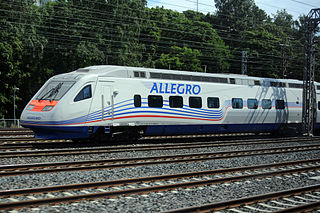
Allegro was the brand name of a now defunct high-speed train service, operated by Alstom VR Class Sm6 trains, between Helsinki, Finland, and St. Petersburg, Russia.
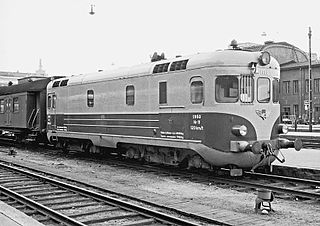
The VR Class Hr11 was the first class of line-haul diesel locomotives used by Valtionrautatiet. Only five units were built, all delivered by Valmet in 1955. The Maybach diesel engines used in the locomotives proved highly unreliable, resulting in a complete overhaul of the engine-transmission system in 1956–58, but this did not solve all of the reliability problems. The Hr11 series was withdrawn from service in 1972.
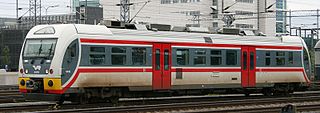
The Dm12 is a diesel railcar operated by VR Group.
The Dm11 was a diesel multiple unit built by GEC-Alsthom in Spain for VR Group. A total of 16 units were ordered in 1995, with an option of 16 more, at a price of 80 million Finnish marks. The first units arrived in Finland in February 1997 and testing started in Central Finland a month later. However, VR cancelled the deal at the end of the same year. By that time, six units had been delivered. The trains left Finland in 1999. One of the units was later seen in Vilnius, Lithuania in 2000 before they were sold to Cuba. The train was unofficially called the Mandolino, which rhymed with the then-new Pendolino.

Before 1942, the VR Class Vr1 were originally classified as L1. The Vr1 was a powerful and effective locomotive. Part of them were built by Tampella and part by Hannoversche Maschinenbau AG of Germany. They were numbered 530–544, 656–670, 787–799 and were nicknamed “Kana” ("Hen"). They were operation from 1913-1974.

The Hikiä railway station is located in Hausjärvi, Finland, in the village and urban area of Hikiä. It is located along the Riihimäki–Lahti line, and its neighboring stations are Riihimäki in the west and Oitti in the east.

The Mommila railway station is located in Hausjärvi, Finland, in the village of Mommila. It is located along the Riihimäki–Lahti line, and its neighboring stations are Oitti in the west and Lappila in the east.
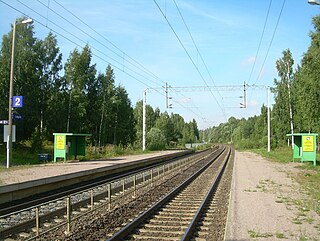
The Lappila railway station is located in Kärkölä, Finland, in the village and urban area of Lappila. It is located along the Riihimäki–Lahti line, and its neighboring stations are Mommila in the west and Järvelä in the east.
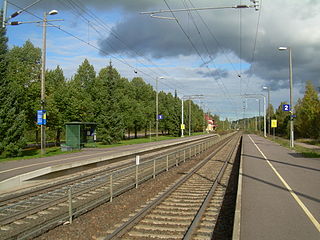
The Herrala railway station is located in Hollola, Finland, in the village and urban area of Herrala. It is located along the Riihimäki–Lahti line, and its neighboring stations are Järvelä in the west and Lahti in the east.

The Uusikylä railway station is located in the city of Lahti, Finland, in the district of Uusikylä. It is located along the Lahti–Kouvola line, and its neighboring stations are Nastola in the west and Kausala in the east.

The Savonlinna railway station is located in the town of Savonlinna, Finland. It is located along the Huutokoski–Parikkala railway, and its only neighboring station is Pääskylahti in the west.

The Nikkilä railway station is located in the village and urban area of Nikkilä, in the municipality of Sipoo, Finland.

The Lyly railway station is a closed station located in the municipality of Juupajoki, Finland, in the village of Lyly. It was located along the Tampere–Haapamäki railway, and its nearest open stations are Korkeakoski and Juupajoki in the south and Vilppula in the north.

The Vaajakoski railway station is a station located in the district of Vaajakoski in the city of Jyväskylä, Finland. It is located along the Jyväskylä–Pieksämäki railway, and has since 1992 only served freight traffic, as well as a passing loop; the nearest station with passenger services is Jyväskylä in the west.























